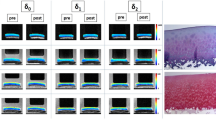Abstract
Cartilage degeneration in osteoarthritis is initiated by a loss of proteoglycan. Intra-articular injection of papain causes a reversible loss of proteoglycan in rabbit knees. Rabbits were scanned with magnetic resonance imaging (MRI), using a 1.5T Signa superconducting magnet with 3 inch surface coil. Spin echo sequences were performed in the coronal and sagittal planes at 0, 24, 48, and 72 h after intra-articular injection of papain to obtain T1, proton density, and T2-weighted images. Cartilage proteoglycan content was measured biochemically and histochemically. Reduced articular cartilage thickness in the MR images of papain-treated knees corresponded to changes in cartilage proteoglycan content.
Similar content being viewed by others
References
Adams ME, Li DKB (1986) Magnetic resonance imaging of joint lesions. In: Kuettner K (ed) Articular cartilage biochemistry. Raven, New York, p 331
Checkley D, Johnstone D, Taylor K, Waterson JC (1989) High resolution NMR imaging of an antigen-induced arthritis in the rabbit knee. Magn Reson Med 11:221
Colombo C, Butler M, O'Byrne E, Hickman L, Swartzendruber D, Selwyn M, Steinetz BG (1983) A new model of osteoarthritis in rabbits. 1. Development of knee joint pathology following lateral meniscectomy and section of the fibular collateral and sesamoid ligaments. Arthritis Rheum 26:875
Dingle JT, Page-Thomas DP, King B, Bard DR (1987) In vivo studies of articular tissue damage mediated by 6 catabolin/interleukin 1. Ann Rheum Dis 46:527
Farkas T, Bihari-Varga M, Biro T (1974) Thermoanalytical and histological study of intra-articular papain-induced degradation and repair of rabbit cartilage. Ann Rheum Dis 33:385
Farnsdale RW, Sayers CA, Barrett AJ (1982) A direct spectrophotometric microassay for sulfated glycosaminoglycans in cartilage cultures. Connect Tissue Res 9:247
Gallimore GW, Harms SE (1986) Knee injuries: high-resolution MR imaging. Radiology 160:457
Harms SE, Flamig DP, Fisher CF, Fulmer JM (1989) New method for fast MR imaging of the knee. Radiology 173:743
Hermann K, Aicher K, Klose U (1988) Quantitative evaluation of hyaline cartilage disorders using the FLASH sequence. Book of Soc Magn Reson in Med 1:188
Kellgren JH (1961) Osteoarthritis in patients and populations. Br Med J 2:1
Kempson GE (1974) Mechanical properties of articular cartilage. In: Freeman MAR (ed) Adult articular cartilage. Pitman Medical, London, p 171
Konig H, Sauter R, Deimling M, Vogt M (1987) Cartilage disorders: comparison of spin-echo, CHESS, and FLASH sequence MR images. Radiology 164:753
Li KC, Higgs J, Aisen AM, Buckwalter KA, Martel W, McCune WJ (1988) MRI in osteoarthritis of the hip: gradations of severity. Magn Reson Imaging 6:229
Luna LG (1960) Manual of histologic staining. Methods of the Armed Forces Institute of Pathology, 3rd ed, McGraw-Hill, New York
Mankin HJ (1973) Biochemical and metabolic abnormalities in osteoarthritic human cartilage. Fed Proc 32:1478
Maroudas A (1974) Physiochemical properties of articular cartilage. In: Freeman MAR (ed) Adult articular cartilage. Pitman Medical, London, p 131
Maroudas A, Venn M (1977) Chemical composition and swelling of normal and osteoarthritic femoral head cartilage II. Swelling. Ann Rheum Dis 36:399
Murray DG (1964) Experimentally induced arthritis using intra-articular papain. Arthritis Rheum 7:211
O'Connor P, Brereton JD, Gardner DL (1984) Hyaline articular cartilage dissected by papain: light and scanning electron microscopy and micromechanical analysis. Ann Rheum Dis 43:320
Solomon SL, Totty WG, Lee JKT (1989) MR imaging of the knee: comparison of three-dimensional FISP and two-dimensional spin-echo pulse sequences. Radiology 173:739
Terrier F, Hricak H, Revel D, Alpers CE, Reinhold CE, Levine J, Genant HK (1985) Magnetic resonance imaging and spectroscopy of the periarticular inflammatory soft-tissue changes in experimental arthritis of the rat. Invest Radiol 20:813
Thomas L, McCluskey RT, Potter JL, Weissmann G (1960) Comparison of the effects of papain and vitamin A on cartilage I. The effects in rabbits. J Exp Med 111:705
Touggaard L (1973) The degree of mineralization in bone tissue: the phosphorus/hydroxyproline ratio determined on small amounts of bone tissue. Scand J Clin Lab Invest 32:351
Williams JM, Downey C, Thonar EJ-MA (1988) Increase in levels of serum keratan sulfate following cartilage proteoglycan degradation in the rabbit knee. Arthritis Rheum 31:557
Woessner JF (1961) The determination of hydroxyproline in tissue and protein samples containing small proportions of this amino acid. Arch Biochem Biophys 93:440
Wojtys E, Wilson M, Buckwalter K, Braunstein EM, Martel W (1987) Magnetic resonance imaging of knee hyaline cartilage and intraarticular pathology. Am J Sports Med 15:455
Author information
Authors and Affiliations
Rights and permissions
About this article
Cite this article
Paul, P.K., O'Byrne, E., Blancuzzi, V. et al. Magnetic resonance imaging reflects cartilage proteoglycan degradation in the rabbit knee. Skeletal Radiol. 20, 31–36 (1991). https://doi.org/10.1007/BF00243718
Issue Date:
DOI: https://doi.org/10.1007/BF00243718




